Leisure Choice International Case Study: HRM and Globalization
VerifiedAdded on 2023/04/12
|12
|3761
|399
Case Study
AI Summary
This case study examines the global HRM strategies of Leisure Choice International, a sports and leisure company undergoing a 10-year globalization process. It discusses the concepts of internationalization and globalization, highlighting the differences between international, multinational, global, and transnational companies. The report analyzes the pressures of global integration and local responsiveness, and how MNCs balance these competing forces. It further explores recruitment and selection methods in an international context, including challenges at macro, meso, and micro levels. The study also addresses the importance of training and management development for MNCs, focusing on cultural awareness and leadership. Finally, it considers the benefits and limitations of standardization strategies in HRM, evaluating the advantages and disadvantages of moving from a diversified to an integrated strategy. This document is available on Desklib, a platform offering a range of study tools for students.
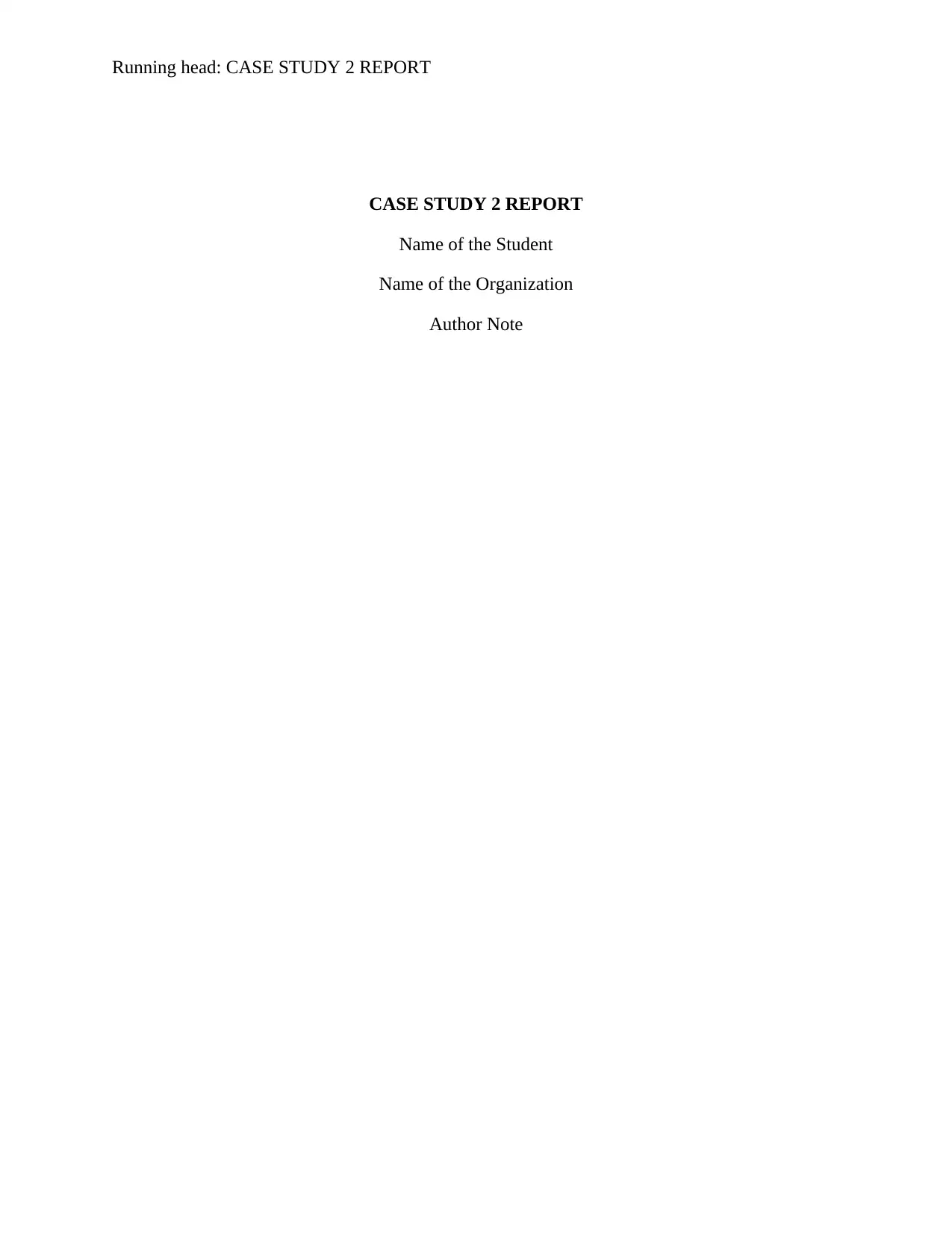
Running head: CASE STUDY 2 REPORT
CASE STUDY 2 REPORT
Name of the Student
Name of the Organization
Author Note
CASE STUDY 2 REPORT
Name of the Student
Name of the Organization
Author Note
Paraphrase This Document
Need a fresh take? Get an instant paraphrase of this document with our AI Paraphraser
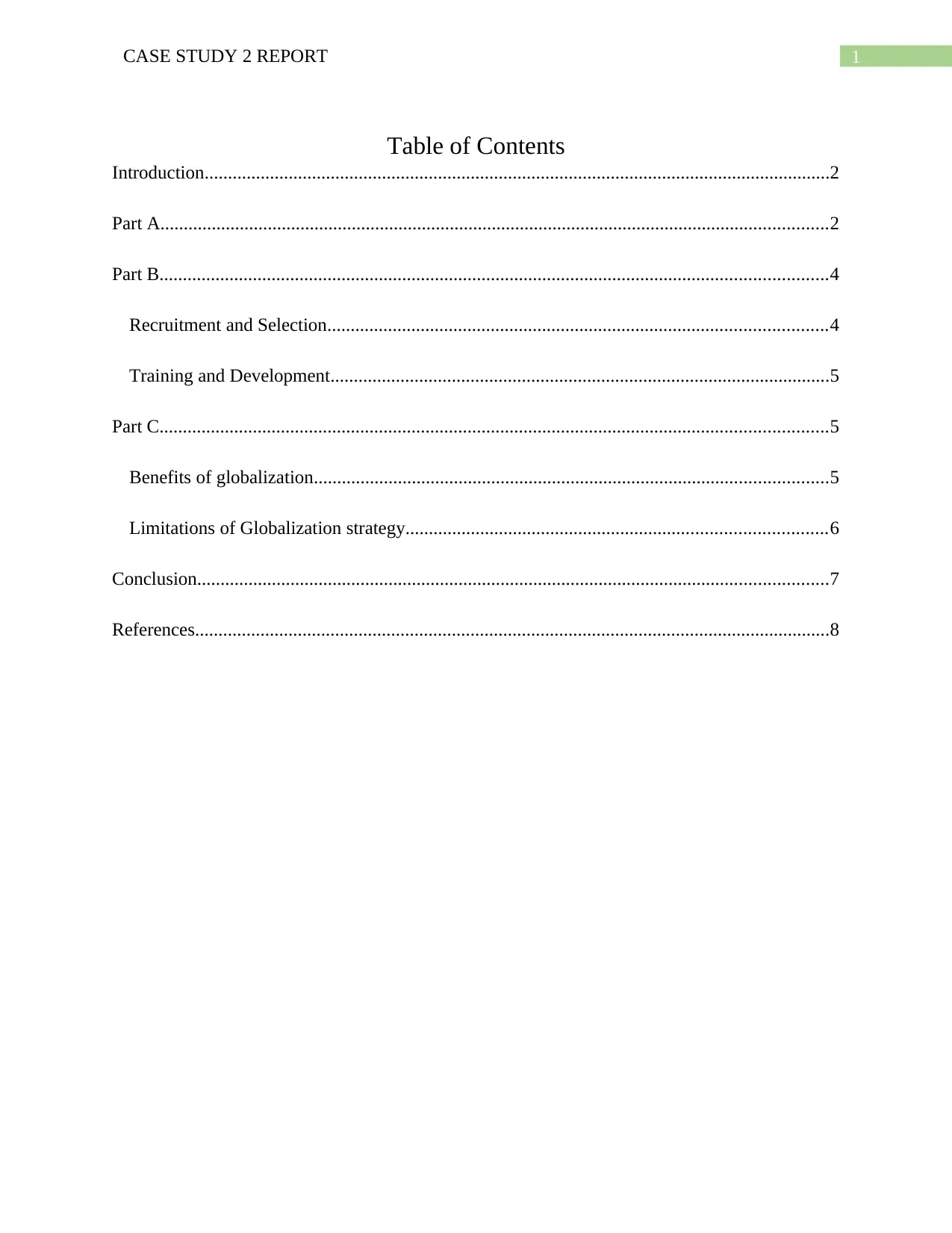
1CASE STUDY 2 REPORT
Table of Contents
Introduction......................................................................................................................................2
Part A...............................................................................................................................................2
Part B...............................................................................................................................................4
Recruitment and Selection...........................................................................................................4
Training and Development...........................................................................................................5
Part C...............................................................................................................................................5
Benefits of globalization..............................................................................................................5
Limitations of Globalization strategy..........................................................................................6
Conclusion.......................................................................................................................................7
References........................................................................................................................................8
Table of Contents
Introduction......................................................................................................................................2
Part A...............................................................................................................................................2
Part B...............................................................................................................................................4
Recruitment and Selection...........................................................................................................4
Training and Development...........................................................................................................5
Part C...............................................................................................................................................5
Benefits of globalization..............................................................................................................5
Limitations of Globalization strategy..........................................................................................6
Conclusion.......................................................................................................................................7
References........................................................................................................................................8
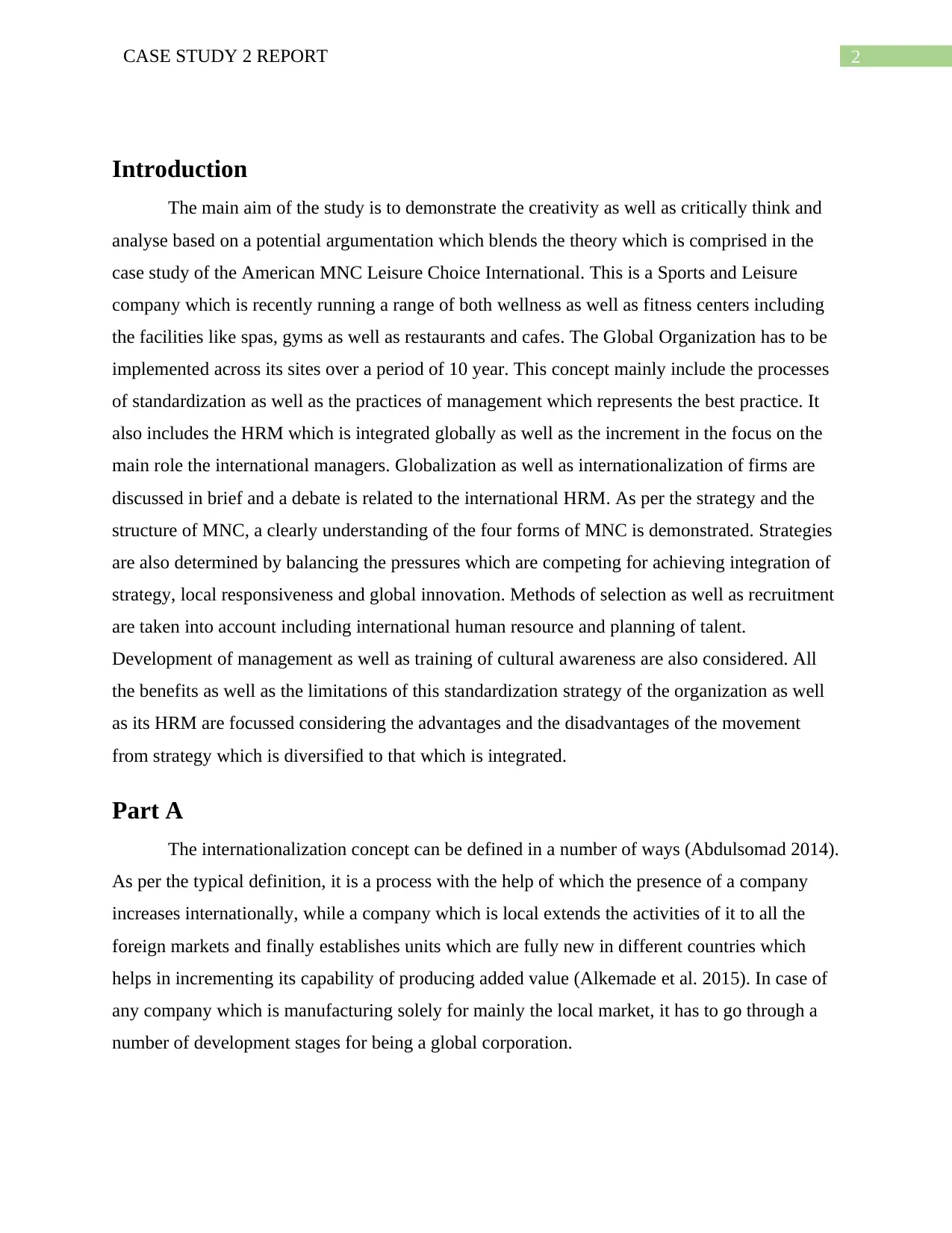
2CASE STUDY 2 REPORT
Introduction
The main aim of the study is to demonstrate the creativity as well as critically think and
analyse based on a potential argumentation which blends the theory which is comprised in the
case study of the American MNC Leisure Choice International. This is a Sports and Leisure
company which is recently running a range of both wellness as well as fitness centers including
the facilities like spas, gyms as well as restaurants and cafes. The Global Organization has to be
implemented across its sites over a period of 10 year. This concept mainly include the processes
of standardization as well as the practices of management which represents the best practice. It
also includes the HRM which is integrated globally as well as the increment in the focus on the
main role the international managers. Globalization as well as internationalization of firms are
discussed in brief and a debate is related to the international HRM. As per the strategy and the
structure of MNC, a clearly understanding of the four forms of MNC is demonstrated. Strategies
are also determined by balancing the pressures which are competing for achieving integration of
strategy, local responsiveness and global innovation. Methods of selection as well as recruitment
are taken into account including international human resource and planning of talent.
Development of management as well as training of cultural awareness are also considered. All
the benefits as well as the limitations of this standardization strategy of the organization as well
as its HRM are focussed considering the advantages and the disadvantages of the movement
from strategy which is diversified to that which is integrated.
Part A
The internationalization concept can be defined in a number of ways (Abdulsomad 2014).
As per the typical definition, it is a process with the help of which the presence of a company
increases internationally, while a company which is local extends the activities of it to all the
foreign markets and finally establishes units which are fully new in different countries which
helps in incrementing its capability of producing added value (Alkemade et al. 2015). In case of
any company which is manufacturing solely for mainly the local market, it has to go through a
number of development stages for being a global corporation.
Introduction
The main aim of the study is to demonstrate the creativity as well as critically think and
analyse based on a potential argumentation which blends the theory which is comprised in the
case study of the American MNC Leisure Choice International. This is a Sports and Leisure
company which is recently running a range of both wellness as well as fitness centers including
the facilities like spas, gyms as well as restaurants and cafes. The Global Organization has to be
implemented across its sites over a period of 10 year. This concept mainly include the processes
of standardization as well as the practices of management which represents the best practice. It
also includes the HRM which is integrated globally as well as the increment in the focus on the
main role the international managers. Globalization as well as internationalization of firms are
discussed in brief and a debate is related to the international HRM. As per the strategy and the
structure of MNC, a clearly understanding of the four forms of MNC is demonstrated. Strategies
are also determined by balancing the pressures which are competing for achieving integration of
strategy, local responsiveness and global innovation. Methods of selection as well as recruitment
are taken into account including international human resource and planning of talent.
Development of management as well as training of cultural awareness are also considered. All
the benefits as well as the limitations of this standardization strategy of the organization as well
as its HRM are focussed considering the advantages and the disadvantages of the movement
from strategy which is diversified to that which is integrated.
Part A
The internationalization concept can be defined in a number of ways (Abdulsomad 2014).
As per the typical definition, it is a process with the help of which the presence of a company
increases internationally, while a company which is local extends the activities of it to all the
foreign markets and finally establishes units which are fully new in different countries which
helps in incrementing its capability of producing added value (Alkemade et al. 2015). In case of
any company which is manufacturing solely for mainly the local market, it has to go through a
number of development stages for being a global corporation.
⊘ This is a preview!⊘
Do you want full access?
Subscribe today to unlock all pages.

Trusted by 1+ million students worldwide
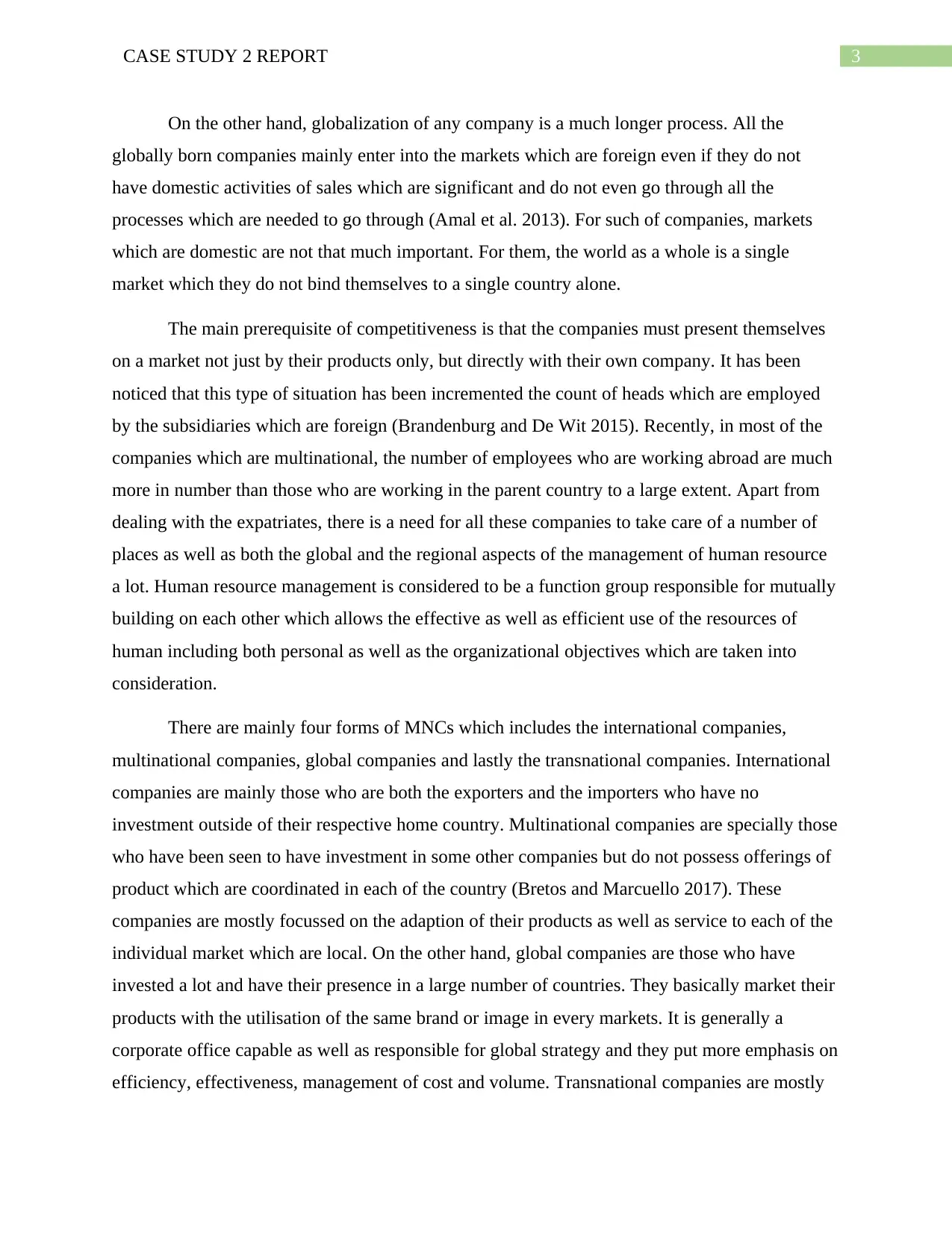
3CASE STUDY 2 REPORT
On the other hand, globalization of any company is a much longer process. All the
globally born companies mainly enter into the markets which are foreign even if they do not
have domestic activities of sales which are significant and do not even go through all the
processes which are needed to go through (Amal et al. 2013). For such of companies, markets
which are domestic are not that much important. For them, the world as a whole is a single
market which they do not bind themselves to a single country alone.
The main prerequisite of competitiveness is that the companies must present themselves
on a market not just by their products only, but directly with their own company. It has been
noticed that this type of situation has been incremented the count of heads which are employed
by the subsidiaries which are foreign (Brandenburg and De Wit 2015). Recently, in most of the
companies which are multinational, the number of employees who are working abroad are much
more in number than those who are working in the parent country to a large extent. Apart from
dealing with the expatriates, there is a need for all these companies to take care of a number of
places as well as both the global and the regional aspects of the management of human resource
a lot. Human resource management is considered to be a function group responsible for mutually
building on each other which allows the effective as well as efficient use of the resources of
human including both personal as well as the organizational objectives which are taken into
consideration.
There are mainly four forms of MNCs which includes the international companies,
multinational companies, global companies and lastly the transnational companies. International
companies are mainly those who are both the exporters and the importers who have no
investment outside of their respective home country. Multinational companies are specially those
who have been seen to have investment in some other companies but do not possess offerings of
product which are coordinated in each of the country (Bretos and Marcuello 2017). These
companies are mostly focussed on the adaption of their products as well as service to each of the
individual market which are local. On the other hand, global companies are those who have
invested a lot and have their presence in a large number of countries. They basically market their
products with the utilisation of the same brand or image in every markets. It is generally a
corporate office capable as well as responsible for global strategy and they put more emphasis on
efficiency, effectiveness, management of cost and volume. Transnational companies are mostly
On the other hand, globalization of any company is a much longer process. All the
globally born companies mainly enter into the markets which are foreign even if they do not
have domestic activities of sales which are significant and do not even go through all the
processes which are needed to go through (Amal et al. 2013). For such of companies, markets
which are domestic are not that much important. For them, the world as a whole is a single
market which they do not bind themselves to a single country alone.
The main prerequisite of competitiveness is that the companies must present themselves
on a market not just by their products only, but directly with their own company. It has been
noticed that this type of situation has been incremented the count of heads which are employed
by the subsidiaries which are foreign (Brandenburg and De Wit 2015). Recently, in most of the
companies which are multinational, the number of employees who are working abroad are much
more in number than those who are working in the parent country to a large extent. Apart from
dealing with the expatriates, there is a need for all these companies to take care of a number of
places as well as both the global and the regional aspects of the management of human resource
a lot. Human resource management is considered to be a function group responsible for mutually
building on each other which allows the effective as well as efficient use of the resources of
human including both personal as well as the organizational objectives which are taken into
consideration.
There are mainly four forms of MNCs which includes the international companies,
multinational companies, global companies and lastly the transnational companies. International
companies are mainly those who are both the exporters and the importers who have no
investment outside of their respective home country. Multinational companies are specially those
who have been seen to have investment in some other companies but do not possess offerings of
product which are coordinated in each of the country (Bretos and Marcuello 2017). These
companies are mostly focussed on the adaption of their products as well as service to each of the
individual market which are local. On the other hand, global companies are those who have
invested a lot and have their presence in a large number of countries. They basically market their
products with the utilisation of the same brand or image in every markets. It is generally a
corporate office capable as well as responsible for global strategy and they put more emphasis on
efficiency, effectiveness, management of cost and volume. Transnational companies are mostly
Paraphrase This Document
Need a fresh take? Get an instant paraphrase of this document with our AI Paraphraser
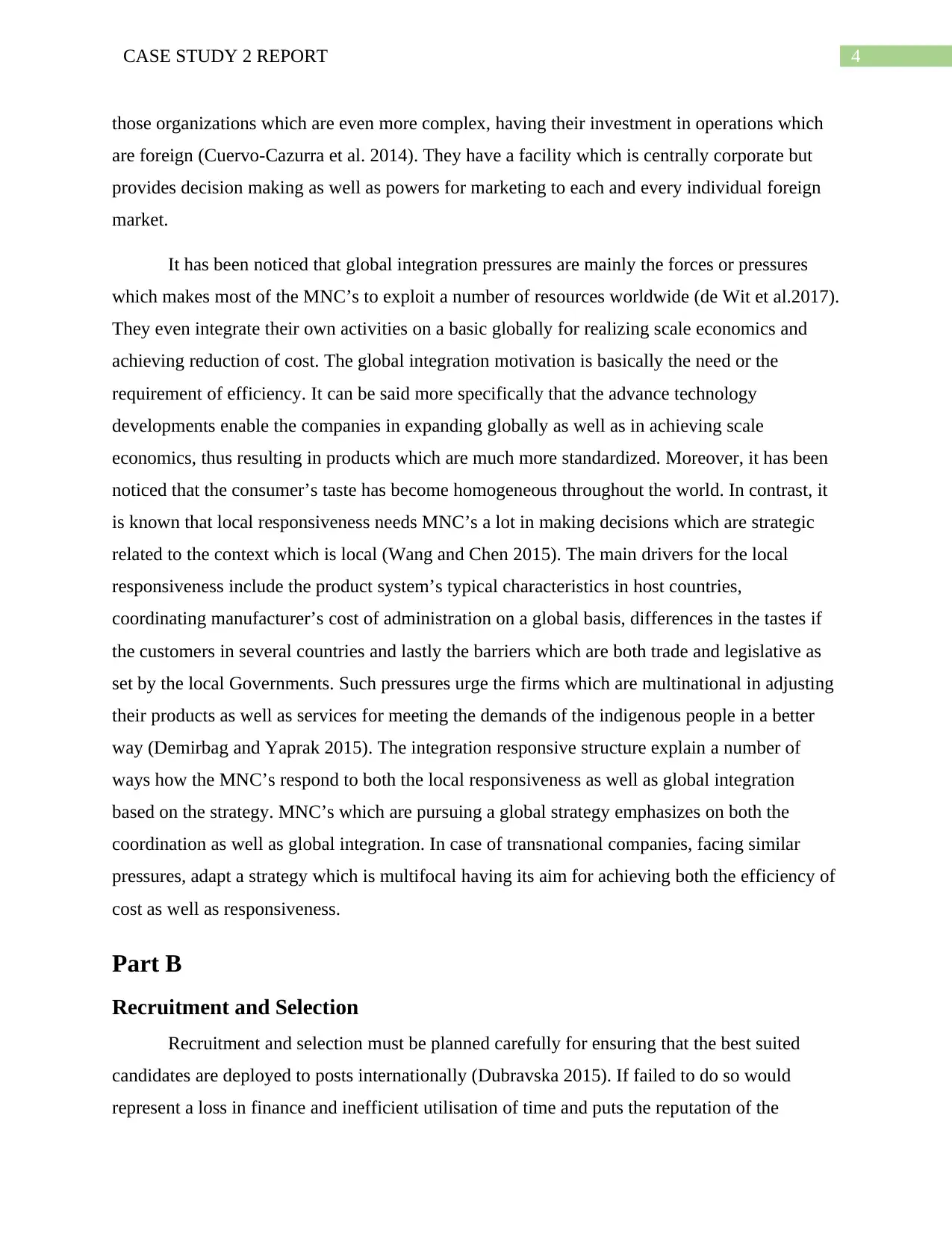
4CASE STUDY 2 REPORT
those organizations which are even more complex, having their investment in operations which
are foreign (Cuervo-Cazurra et al. 2014). They have a facility which is centrally corporate but
provides decision making as well as powers for marketing to each and every individual foreign
market.
It has been noticed that global integration pressures are mainly the forces or pressures
which makes most of the MNC’s to exploit a number of resources worldwide (de Wit et al.2017).
They even integrate their own activities on a basic globally for realizing scale economics and
achieving reduction of cost. The global integration motivation is basically the need or the
requirement of efficiency. It can be said more specifically that the advance technology
developments enable the companies in expanding globally as well as in achieving scale
economics, thus resulting in products which are much more standardized. Moreover, it has been
noticed that the consumer’s taste has become homogeneous throughout the world. In contrast, it
is known that local responsiveness needs MNC’s a lot in making decisions which are strategic
related to the context which is local (Wang and Chen 2015). The main drivers for the local
responsiveness include the product system’s typical characteristics in host countries,
coordinating manufacturer’s cost of administration on a global basis, differences in the tastes if
the customers in several countries and lastly the barriers which are both trade and legislative as
set by the local Governments. Such pressures urge the firms which are multinational in adjusting
their products as well as services for meeting the demands of the indigenous people in a better
way (Demirbag and Yaprak 2015). The integration responsive structure explain a number of
ways how the MNC’s respond to both the local responsiveness as well as global integration
based on the strategy. MNC’s which are pursuing a global strategy emphasizes on both the
coordination as well as global integration. In case of transnational companies, facing similar
pressures, adapt a strategy which is multifocal having its aim for achieving both the efficiency of
cost as well as responsiveness.
Part B
Recruitment and Selection
Recruitment and selection must be planned carefully for ensuring that the best suited
candidates are deployed to posts internationally (Dubravska 2015). If failed to do so would
represent a loss in finance and inefficient utilisation of time and puts the reputation of the
those organizations which are even more complex, having their investment in operations which
are foreign (Cuervo-Cazurra et al. 2014). They have a facility which is centrally corporate but
provides decision making as well as powers for marketing to each and every individual foreign
market.
It has been noticed that global integration pressures are mainly the forces or pressures
which makes most of the MNC’s to exploit a number of resources worldwide (de Wit et al.2017).
They even integrate their own activities on a basic globally for realizing scale economics and
achieving reduction of cost. The global integration motivation is basically the need or the
requirement of efficiency. It can be said more specifically that the advance technology
developments enable the companies in expanding globally as well as in achieving scale
economics, thus resulting in products which are much more standardized. Moreover, it has been
noticed that the consumer’s taste has become homogeneous throughout the world. In contrast, it
is known that local responsiveness needs MNC’s a lot in making decisions which are strategic
related to the context which is local (Wang and Chen 2015). The main drivers for the local
responsiveness include the product system’s typical characteristics in host countries,
coordinating manufacturer’s cost of administration on a global basis, differences in the tastes if
the customers in several countries and lastly the barriers which are both trade and legislative as
set by the local Governments. Such pressures urge the firms which are multinational in adjusting
their products as well as services for meeting the demands of the indigenous people in a better
way (Demirbag and Yaprak 2015). The integration responsive structure explain a number of
ways how the MNC’s respond to both the local responsiveness as well as global integration
based on the strategy. MNC’s which are pursuing a global strategy emphasizes on both the
coordination as well as global integration. In case of transnational companies, facing similar
pressures, adapt a strategy which is multifocal having its aim for achieving both the efficiency of
cost as well as responsiveness.
Part B
Recruitment and Selection
Recruitment and selection must be planned carefully for ensuring that the best suited
candidates are deployed to posts internationally (Dubravska 2015). If failed to do so would
represent a loss in finance and inefficient utilisation of time and puts the reputation of the
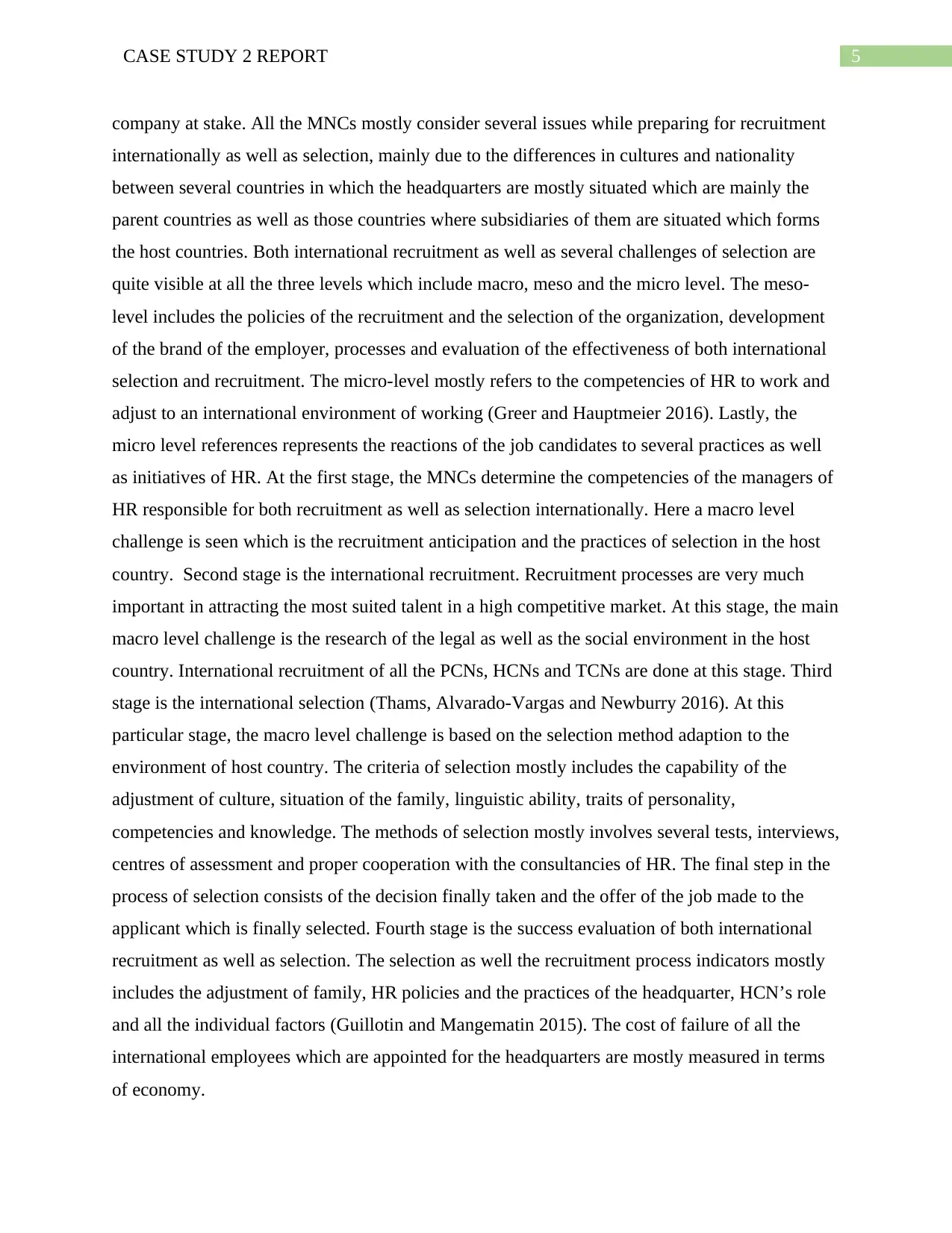
5CASE STUDY 2 REPORT
company at stake. All the MNCs mostly consider several issues while preparing for recruitment
internationally as well as selection, mainly due to the differences in cultures and nationality
between several countries in which the headquarters are mostly situated which are mainly the
parent countries as well as those countries where subsidiaries of them are situated which forms
the host countries. Both international recruitment as well as several challenges of selection are
quite visible at all the three levels which include macro, meso and the micro level. The meso-
level includes the policies of the recruitment and the selection of the organization, development
of the brand of the employer, processes and evaluation of the effectiveness of both international
selection and recruitment. The micro-level mostly refers to the competencies of HR to work and
adjust to an international environment of working (Greer and Hauptmeier 2016). Lastly, the
micro level references represents the reactions of the job candidates to several practices as well
as initiatives of HR. At the first stage, the MNCs determine the competencies of the managers of
HR responsible for both recruitment as well as selection internationally. Here a macro level
challenge is seen which is the recruitment anticipation and the practices of selection in the host
country. Second stage is the international recruitment. Recruitment processes are very much
important in attracting the most suited talent in a high competitive market. At this stage, the main
macro level challenge is the research of the legal as well as the social environment in the host
country. International recruitment of all the PCNs, HCNs and TCNs are done at this stage. Third
stage is the international selection (Thams, Alvarado-Vargas and Newburry 2016). At this
particular stage, the macro level challenge is based on the selection method adaption to the
environment of host country. The criteria of selection mostly includes the capability of the
adjustment of culture, situation of the family, linguistic ability, traits of personality,
competencies and knowledge. The methods of selection mostly involves several tests, interviews,
centres of assessment and proper cooperation with the consultancies of HR. The final step in the
process of selection consists of the decision finally taken and the offer of the job made to the
applicant which is finally selected. Fourth stage is the success evaluation of both international
recruitment as well as selection. The selection as well the recruitment process indicators mostly
includes the adjustment of family, HR policies and the practices of the headquarter, HCN’s role
and all the individual factors (Guillotin and Mangematin 2015). The cost of failure of all the
international employees which are appointed for the headquarters are mostly measured in terms
of economy.
company at stake. All the MNCs mostly consider several issues while preparing for recruitment
internationally as well as selection, mainly due to the differences in cultures and nationality
between several countries in which the headquarters are mostly situated which are mainly the
parent countries as well as those countries where subsidiaries of them are situated which forms
the host countries. Both international recruitment as well as several challenges of selection are
quite visible at all the three levels which include macro, meso and the micro level. The meso-
level includes the policies of the recruitment and the selection of the organization, development
of the brand of the employer, processes and evaluation of the effectiveness of both international
selection and recruitment. The micro-level mostly refers to the competencies of HR to work and
adjust to an international environment of working (Greer and Hauptmeier 2016). Lastly, the
micro level references represents the reactions of the job candidates to several practices as well
as initiatives of HR. At the first stage, the MNCs determine the competencies of the managers of
HR responsible for both recruitment as well as selection internationally. Here a macro level
challenge is seen which is the recruitment anticipation and the practices of selection in the host
country. Second stage is the international recruitment. Recruitment processes are very much
important in attracting the most suited talent in a high competitive market. At this stage, the main
macro level challenge is the research of the legal as well as the social environment in the host
country. International recruitment of all the PCNs, HCNs and TCNs are done at this stage. Third
stage is the international selection (Thams, Alvarado-Vargas and Newburry 2016). At this
particular stage, the macro level challenge is based on the selection method adaption to the
environment of host country. The criteria of selection mostly includes the capability of the
adjustment of culture, situation of the family, linguistic ability, traits of personality,
competencies and knowledge. The methods of selection mostly involves several tests, interviews,
centres of assessment and proper cooperation with the consultancies of HR. The final step in the
process of selection consists of the decision finally taken and the offer of the job made to the
applicant which is finally selected. Fourth stage is the success evaluation of both international
recruitment as well as selection. The selection as well the recruitment process indicators mostly
includes the adjustment of family, HR policies and the practices of the headquarter, HCN’s role
and all the individual factors (Guillotin and Mangematin 2015). The cost of failure of all the
international employees which are appointed for the headquarters are mostly measured in terms
of economy.
⊘ This is a preview!⊘
Do you want full access?
Subscribe today to unlock all pages.

Trusted by 1+ million students worldwide
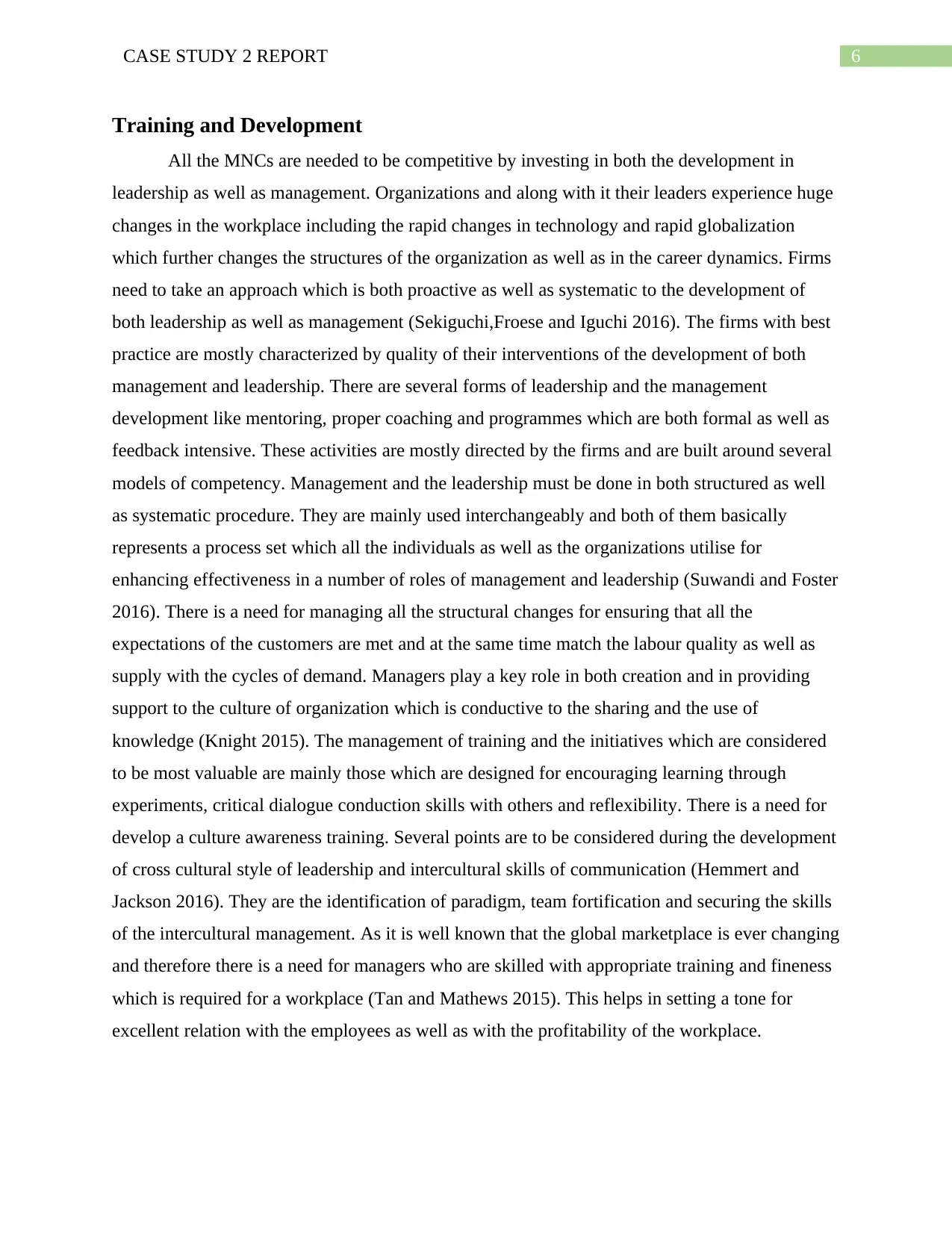
6CASE STUDY 2 REPORT
Training and Development
All the MNCs are needed to be competitive by investing in both the development in
leadership as well as management. Organizations and along with it their leaders experience huge
changes in the workplace including the rapid changes in technology and rapid globalization
which further changes the structures of the organization as well as in the career dynamics. Firms
need to take an approach which is both proactive as well as systematic to the development of
both leadership as well as management (Sekiguchi,Froese and Iguchi 2016). The firms with best
practice are mostly characterized by quality of their interventions of the development of both
management and leadership. There are several forms of leadership and the management
development like mentoring, proper coaching and programmes which are both formal as well as
feedback intensive. These activities are mostly directed by the firms and are built around several
models of competency. Management and the leadership must be done in both structured as well
as systematic procedure. They are mainly used interchangeably and both of them basically
represents a process set which all the individuals as well as the organizations utilise for
enhancing effectiveness in a number of roles of management and leadership (Suwandi and Foster
2016). There is a need for managing all the structural changes for ensuring that all the
expectations of the customers are met and at the same time match the labour quality as well as
supply with the cycles of demand. Managers play a key role in both creation and in providing
support to the culture of organization which is conductive to the sharing and the use of
knowledge (Knight 2015). The management of training and the initiatives which are considered
to be most valuable are mainly those which are designed for encouraging learning through
experiments, critical dialogue conduction skills with others and reflexibility. There is a need for
develop a culture awareness training. Several points are to be considered during the development
of cross cultural style of leadership and intercultural skills of communication (Hemmert and
Jackson 2016). They are the identification of paradigm, team fortification and securing the skills
of the intercultural management. As it is well known that the global marketplace is ever changing
and therefore there is a need for managers who are skilled with appropriate training and fineness
which is required for a workplace (Tan and Mathews 2015). This helps in setting a tone for
excellent relation with the employees as well as with the profitability of the workplace.
Training and Development
All the MNCs are needed to be competitive by investing in both the development in
leadership as well as management. Organizations and along with it their leaders experience huge
changes in the workplace including the rapid changes in technology and rapid globalization
which further changes the structures of the organization as well as in the career dynamics. Firms
need to take an approach which is both proactive as well as systematic to the development of
both leadership as well as management (Sekiguchi,Froese and Iguchi 2016). The firms with best
practice are mostly characterized by quality of their interventions of the development of both
management and leadership. There are several forms of leadership and the management
development like mentoring, proper coaching and programmes which are both formal as well as
feedback intensive. These activities are mostly directed by the firms and are built around several
models of competency. Management and the leadership must be done in both structured as well
as systematic procedure. They are mainly used interchangeably and both of them basically
represents a process set which all the individuals as well as the organizations utilise for
enhancing effectiveness in a number of roles of management and leadership (Suwandi and Foster
2016). There is a need for managing all the structural changes for ensuring that all the
expectations of the customers are met and at the same time match the labour quality as well as
supply with the cycles of demand. Managers play a key role in both creation and in providing
support to the culture of organization which is conductive to the sharing and the use of
knowledge (Knight 2015). The management of training and the initiatives which are considered
to be most valuable are mainly those which are designed for encouraging learning through
experiments, critical dialogue conduction skills with others and reflexibility. There is a need for
develop a culture awareness training. Several points are to be considered during the development
of cross cultural style of leadership and intercultural skills of communication (Hemmert and
Jackson 2016). They are the identification of paradigm, team fortification and securing the skills
of the intercultural management. As it is well known that the global marketplace is ever changing
and therefore there is a need for managers who are skilled with appropriate training and fineness
which is required for a workplace (Tan and Mathews 2015). This helps in setting a tone for
excellent relation with the employees as well as with the profitability of the workplace.
Paraphrase This Document
Need a fresh take? Get an instant paraphrase of this document with our AI Paraphraser
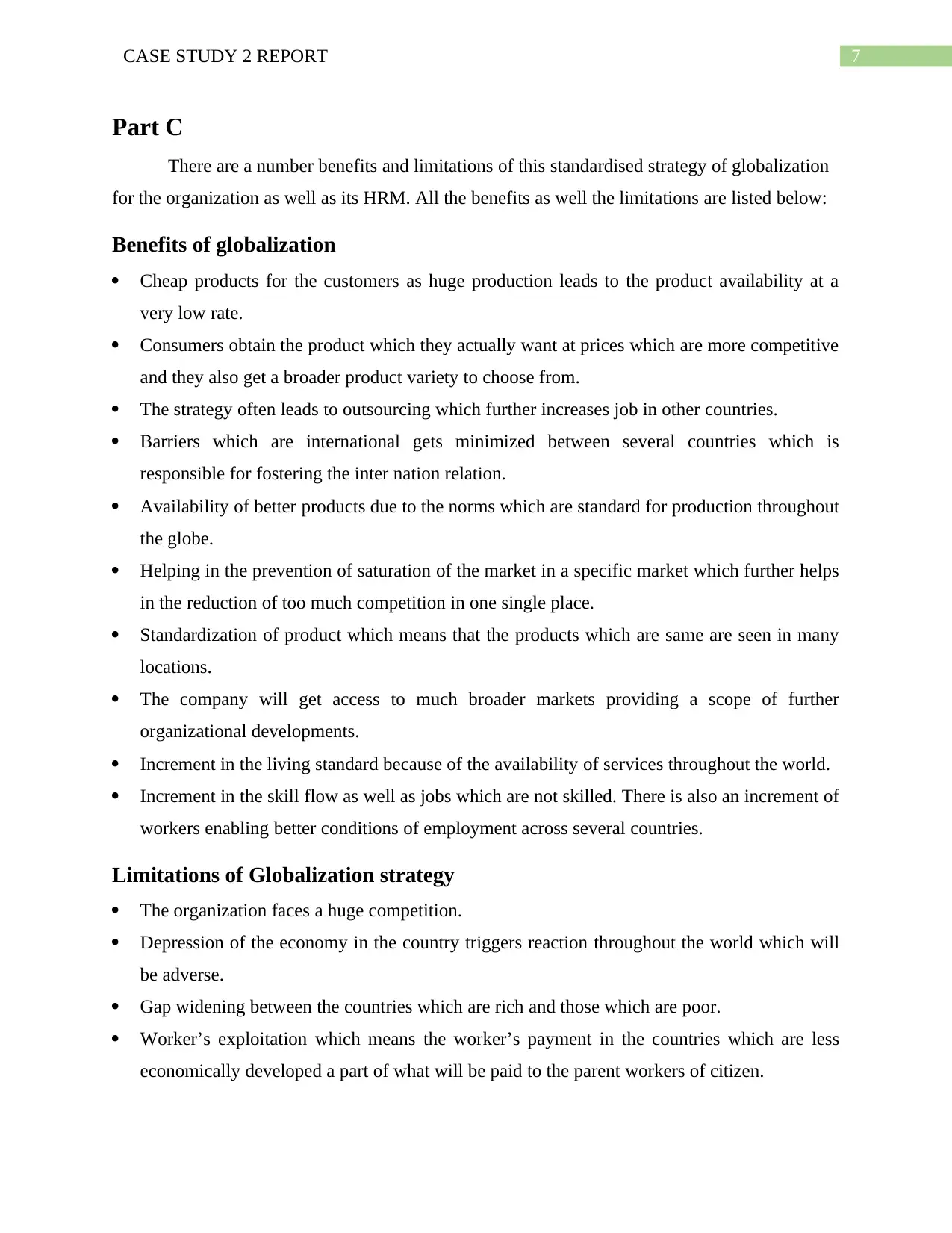
7CASE STUDY 2 REPORT
Part C
There are a number benefits and limitations of this standardised strategy of globalization
for the organization as well as its HRM. All the benefits as well the limitations are listed below:
Benefits of globalization
Cheap products for the customers as huge production leads to the product availability at a
very low rate.
Consumers obtain the product which they actually want at prices which are more competitive
and they also get a broader product variety to choose from.
The strategy often leads to outsourcing which further increases job in other countries.
Barriers which are international gets minimized between several countries which is
responsible for fostering the inter nation relation.
Availability of better products due to the norms which are standard for production throughout
the globe.
Helping in the prevention of saturation of the market in a specific market which further helps
in the reduction of too much competition in one single place.
Standardization of product which means that the products which are same are seen in many
locations.
The company will get access to much broader markets providing a scope of further
organizational developments.
Increment in the living standard because of the availability of services throughout the world.
Increment in the skill flow as well as jobs which are not skilled. There is also an increment of
workers enabling better conditions of employment across several countries.
Limitations of Globalization strategy
The organization faces a huge competition.
Depression of the economy in the country triggers reaction throughout the world which will
be adverse.
Gap widening between the countries which are rich and those which are poor.
Worker’s exploitation which means the worker’s payment in the countries which are less
economically developed a part of what will be paid to the parent workers of citizen.
Part C
There are a number benefits and limitations of this standardised strategy of globalization
for the organization as well as its HRM. All the benefits as well the limitations are listed below:
Benefits of globalization
Cheap products for the customers as huge production leads to the product availability at a
very low rate.
Consumers obtain the product which they actually want at prices which are more competitive
and they also get a broader product variety to choose from.
The strategy often leads to outsourcing which further increases job in other countries.
Barriers which are international gets minimized between several countries which is
responsible for fostering the inter nation relation.
Availability of better products due to the norms which are standard for production throughout
the globe.
Helping in the prevention of saturation of the market in a specific market which further helps
in the reduction of too much competition in one single place.
Standardization of product which means that the products which are same are seen in many
locations.
The company will get access to much broader markets providing a scope of further
organizational developments.
Increment in the living standard because of the availability of services throughout the world.
Increment in the skill flow as well as jobs which are not skilled. There is also an increment of
workers enabling better conditions of employment across several countries.
Limitations of Globalization strategy
The organization faces a huge competition.
Depression of the economy in the country triggers reaction throughout the world which will
be adverse.
Gap widening between the countries which are rich and those which are poor.
Worker’s exploitation which means the worker’s payment in the countries which are less
economically developed a part of what will be paid to the parent workers of citizen.
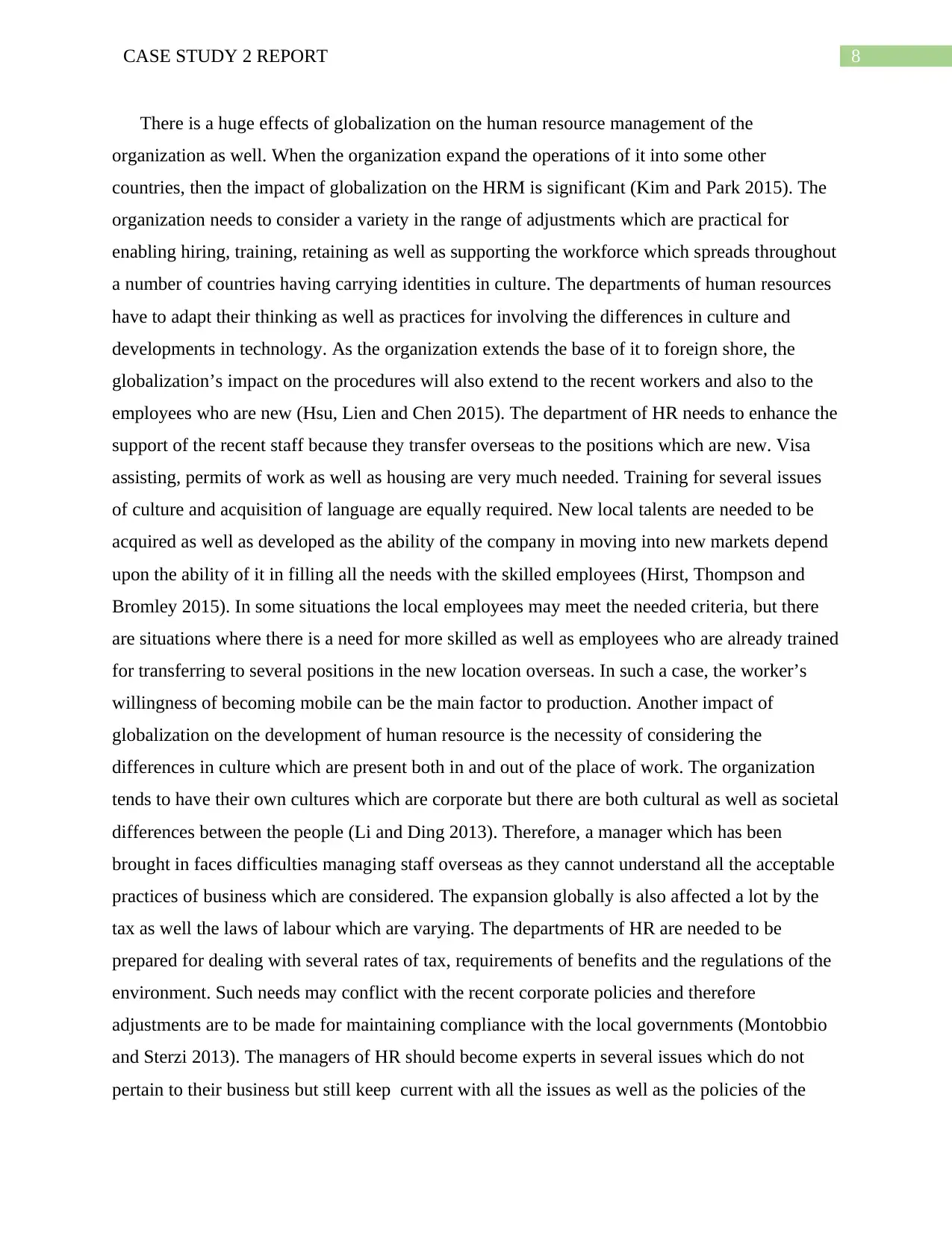
8CASE STUDY 2 REPORT
There is a huge effects of globalization on the human resource management of the
organization as well. When the organization expand the operations of it into some other
countries, then the impact of globalization on the HRM is significant (Kim and Park 2015). The
organization needs to consider a variety in the range of adjustments which are practical for
enabling hiring, training, retaining as well as supporting the workforce which spreads throughout
a number of countries having carrying identities in culture. The departments of human resources
have to adapt their thinking as well as practices for involving the differences in culture and
developments in technology. As the organization extends the base of it to foreign shore, the
globalization’s impact on the procedures will also extend to the recent workers and also to the
employees who are new (Hsu, Lien and Chen 2015). The department of HR needs to enhance the
support of the recent staff because they transfer overseas to the positions which are new. Visa
assisting, permits of work as well as housing are very much needed. Training for several issues
of culture and acquisition of language are equally required. New local talents are needed to be
acquired as well as developed as the ability of the company in moving into new markets depend
upon the ability of it in filling all the needs with the skilled employees (Hirst, Thompson and
Bromley 2015). In some situations the local employees may meet the needed criteria, but there
are situations where there is a need for more skilled as well as employees who are already trained
for transferring to several positions in the new location overseas. In such a case, the worker’s
willingness of becoming mobile can be the main factor to production. Another impact of
globalization on the development of human resource is the necessity of considering the
differences in culture which are present both in and out of the place of work. The organization
tends to have their own cultures which are corporate but there are both cultural as well as societal
differences between the people (Li and Ding 2013). Therefore, a manager which has been
brought in faces difficulties managing staff overseas as they cannot understand all the acceptable
practices of business which are considered. The expansion globally is also affected a lot by the
tax as well the laws of labour which are varying. The departments of HR are needed to be
prepared for dealing with several rates of tax, requirements of benefits and the regulations of the
environment. Such needs may conflict with the recent corporate policies and therefore
adjustments are to be made for maintaining compliance with the local governments (Montobbio
and Sterzi 2013). The managers of HR should become experts in several issues which do not
pertain to their business but still keep current with all the issues as well as the policies of the
There is a huge effects of globalization on the human resource management of the
organization as well. When the organization expand the operations of it into some other
countries, then the impact of globalization on the HRM is significant (Kim and Park 2015). The
organization needs to consider a variety in the range of adjustments which are practical for
enabling hiring, training, retaining as well as supporting the workforce which spreads throughout
a number of countries having carrying identities in culture. The departments of human resources
have to adapt their thinking as well as practices for involving the differences in culture and
developments in technology. As the organization extends the base of it to foreign shore, the
globalization’s impact on the procedures will also extend to the recent workers and also to the
employees who are new (Hsu, Lien and Chen 2015). The department of HR needs to enhance the
support of the recent staff because they transfer overseas to the positions which are new. Visa
assisting, permits of work as well as housing are very much needed. Training for several issues
of culture and acquisition of language are equally required. New local talents are needed to be
acquired as well as developed as the ability of the company in moving into new markets depend
upon the ability of it in filling all the needs with the skilled employees (Hirst, Thompson and
Bromley 2015). In some situations the local employees may meet the needed criteria, but there
are situations where there is a need for more skilled as well as employees who are already trained
for transferring to several positions in the new location overseas. In such a case, the worker’s
willingness of becoming mobile can be the main factor to production. Another impact of
globalization on the development of human resource is the necessity of considering the
differences in culture which are present both in and out of the place of work. The organization
tends to have their own cultures which are corporate but there are both cultural as well as societal
differences between the people (Li and Ding 2013). Therefore, a manager which has been
brought in faces difficulties managing staff overseas as they cannot understand all the acceptable
practices of business which are considered. The expansion globally is also affected a lot by the
tax as well the laws of labour which are varying. The departments of HR are needed to be
prepared for dealing with several rates of tax, requirements of benefits and the regulations of the
environment. Such needs may conflict with the recent corporate policies and therefore
adjustments are to be made for maintaining compliance with the local governments (Montobbio
and Sterzi 2013). The managers of HR should become experts in several issues which do not
pertain to their business but still keep current with all the issues as well as the policies of the
⊘ This is a preview!⊘
Do you want full access?
Subscribe today to unlock all pages.

Trusted by 1+ million students worldwide
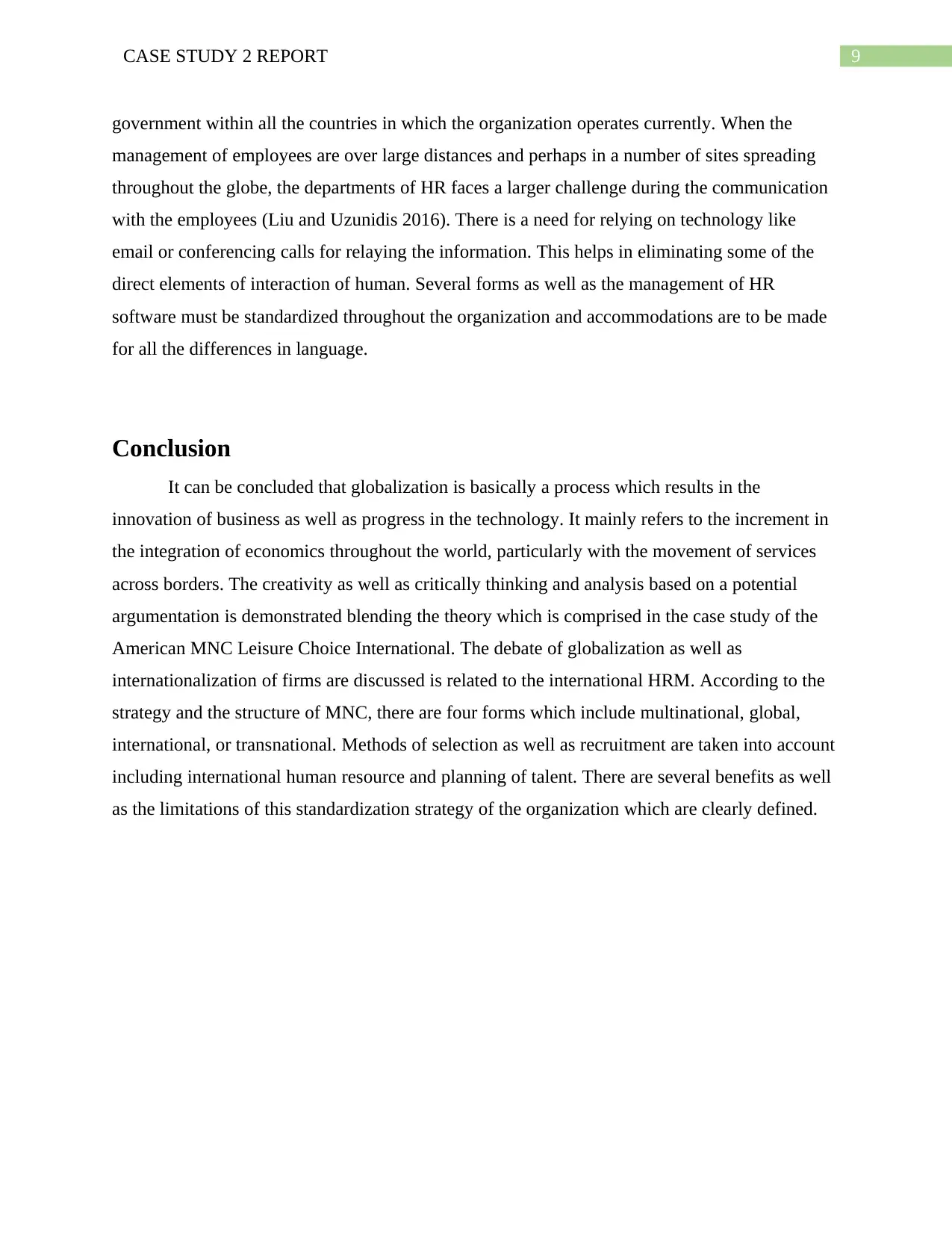
9CASE STUDY 2 REPORT
government within all the countries in which the organization operates currently. When the
management of employees are over large distances and perhaps in a number of sites spreading
throughout the globe, the departments of HR faces a larger challenge during the communication
with the employees (Liu and Uzunidis 2016). There is a need for relying on technology like
email or conferencing calls for relaying the information. This helps in eliminating some of the
direct elements of interaction of human. Several forms as well as the management of HR
software must be standardized throughout the organization and accommodations are to be made
for all the differences in language.
Conclusion
It can be concluded that globalization is basically a process which results in the
innovation of business as well as progress in the technology. It mainly refers to the increment in
the integration of economics throughout the world, particularly with the movement of services
across borders. The creativity as well as critically thinking and analysis based on a potential
argumentation is demonstrated blending the theory which is comprised in the case study of the
American MNC Leisure Choice International. The debate of globalization as well as
internationalization of firms are discussed is related to the international HRM. According to the
strategy and the structure of MNC, there are four forms which include multinational, global,
international, or transnational. Methods of selection as well as recruitment are taken into account
including international human resource and planning of talent. There are several benefits as well
as the limitations of this standardization strategy of the organization which are clearly defined.
government within all the countries in which the organization operates currently. When the
management of employees are over large distances and perhaps in a number of sites spreading
throughout the globe, the departments of HR faces a larger challenge during the communication
with the employees (Liu and Uzunidis 2016). There is a need for relying on technology like
email or conferencing calls for relaying the information. This helps in eliminating some of the
direct elements of interaction of human. Several forms as well as the management of HR
software must be standardized throughout the organization and accommodations are to be made
for all the differences in language.
Conclusion
It can be concluded that globalization is basically a process which results in the
innovation of business as well as progress in the technology. It mainly refers to the increment in
the integration of economics throughout the world, particularly with the movement of services
across borders. The creativity as well as critically thinking and analysis based on a potential
argumentation is demonstrated blending the theory which is comprised in the case study of the
American MNC Leisure Choice International. The debate of globalization as well as
internationalization of firms are discussed is related to the international HRM. According to the
strategy and the structure of MNC, there are four forms which include multinational, global,
international, or transnational. Methods of selection as well as recruitment are taken into account
including international human resource and planning of talent. There are several benefits as well
as the limitations of this standardization strategy of the organization which are clearly defined.
Paraphrase This Document
Need a fresh take? Get an instant paraphrase of this document with our AI Paraphraser
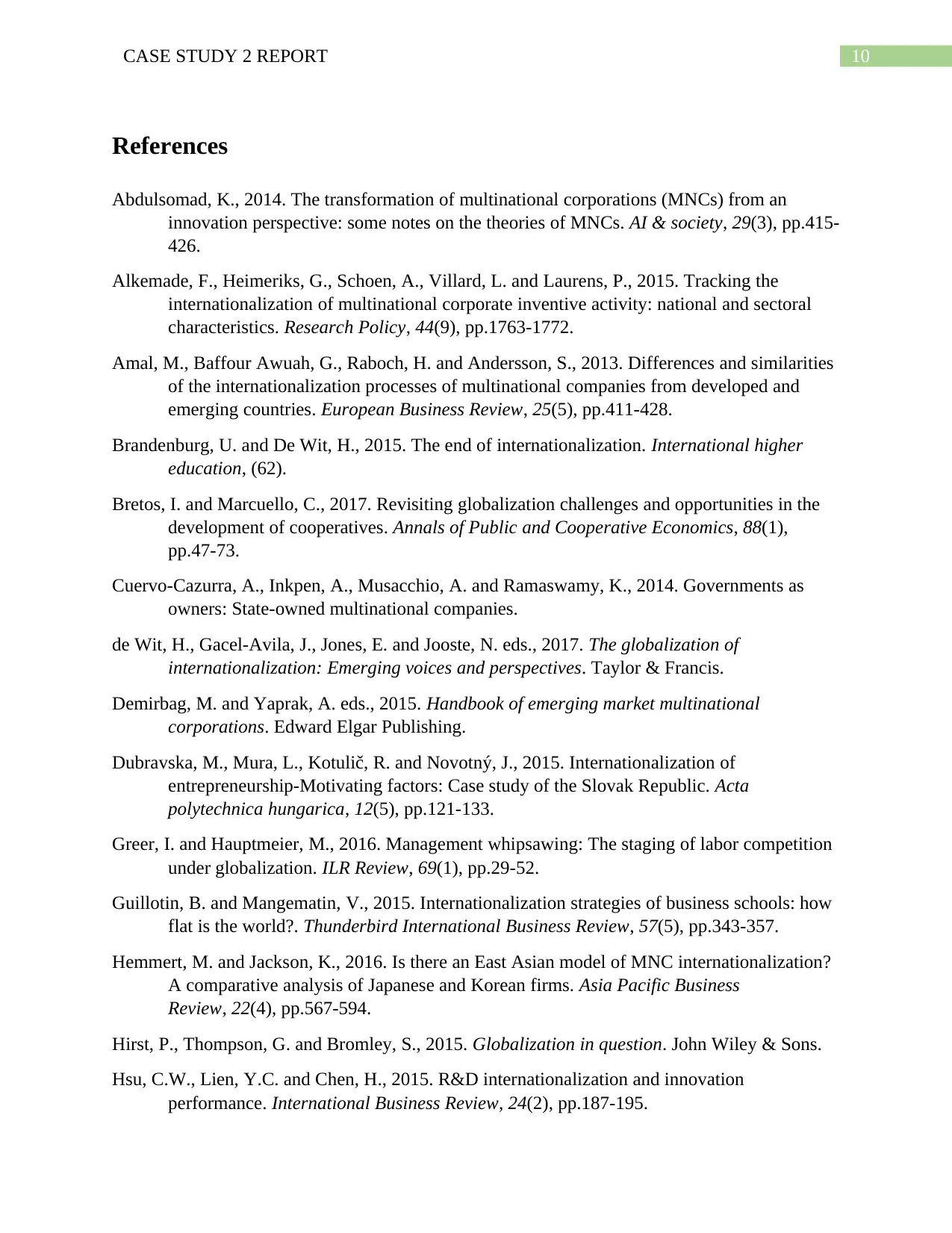
10CASE STUDY 2 REPORT
References
Abdulsomad, K., 2014. The transformation of multinational corporations (MNCs) from an
innovation perspective: some notes on the theories of MNCs. AI & society, 29(3), pp.415-
426.
Alkemade, F., Heimeriks, G., Schoen, A., Villard, L. and Laurens, P., 2015. Tracking the
internationalization of multinational corporate inventive activity: national and sectoral
characteristics. Research Policy, 44(9), pp.1763-1772.
Amal, M., Baffour Awuah, G., Raboch, H. and Andersson, S., 2013. Differences and similarities
of the internationalization processes of multinational companies from developed and
emerging countries. European Business Review, 25(5), pp.411-428.
Brandenburg, U. and De Wit, H., 2015. The end of internationalization. International higher
education, (62).
Bretos, I. and Marcuello, C., 2017. Revisiting globalization challenges and opportunities in the
development of cooperatives. Annals of Public and Cooperative Economics, 88(1),
pp.47-73.
Cuervo-Cazurra, A., Inkpen, A., Musacchio, A. and Ramaswamy, K., 2014. Governments as
owners: State-owned multinational companies.
de Wit, H., Gacel-Avila, J., Jones, E. and Jooste, N. eds., 2017. The globalization of
internationalization: Emerging voices and perspectives. Taylor & Francis.
Demirbag, M. and Yaprak, A. eds., 2015. Handbook of emerging market multinational
corporations. Edward Elgar Publishing.
Dubravska, M., Mura, L., Kotulič, R. and Novotný, J., 2015. Internationalization of
entrepreneurship-Motivating factors: Case study of the Slovak Republic. Acta
polytechnica hungarica, 12(5), pp.121-133.
Greer, I. and Hauptmeier, M., 2016. Management whipsawing: The staging of labor competition
under globalization. ILR Review, 69(1), pp.29-52.
Guillotin, B. and Mangematin, V., 2015. Internationalization strategies of business schools: how
flat is the world?. Thunderbird International Business Review, 57(5), pp.343-357.
Hemmert, M. and Jackson, K., 2016. Is there an East Asian model of MNC internationalization?
A comparative analysis of Japanese and Korean firms. Asia Pacific Business
Review, 22(4), pp.567-594.
Hirst, P., Thompson, G. and Bromley, S., 2015. Globalization in question. John Wiley & Sons.
Hsu, C.W., Lien, Y.C. and Chen, H., 2015. R&D internationalization and innovation
performance. International Business Review, 24(2), pp.187-195.
References
Abdulsomad, K., 2014. The transformation of multinational corporations (MNCs) from an
innovation perspective: some notes on the theories of MNCs. AI & society, 29(3), pp.415-
426.
Alkemade, F., Heimeriks, G., Schoen, A., Villard, L. and Laurens, P., 2015. Tracking the
internationalization of multinational corporate inventive activity: national and sectoral
characteristics. Research Policy, 44(9), pp.1763-1772.
Amal, M., Baffour Awuah, G., Raboch, H. and Andersson, S., 2013. Differences and similarities
of the internationalization processes of multinational companies from developed and
emerging countries. European Business Review, 25(5), pp.411-428.
Brandenburg, U. and De Wit, H., 2015. The end of internationalization. International higher
education, (62).
Bretos, I. and Marcuello, C., 2017. Revisiting globalization challenges and opportunities in the
development of cooperatives. Annals of Public and Cooperative Economics, 88(1),
pp.47-73.
Cuervo-Cazurra, A., Inkpen, A., Musacchio, A. and Ramaswamy, K., 2014. Governments as
owners: State-owned multinational companies.
de Wit, H., Gacel-Avila, J., Jones, E. and Jooste, N. eds., 2017. The globalization of
internationalization: Emerging voices and perspectives. Taylor & Francis.
Demirbag, M. and Yaprak, A. eds., 2015. Handbook of emerging market multinational
corporations. Edward Elgar Publishing.
Dubravska, M., Mura, L., Kotulič, R. and Novotný, J., 2015. Internationalization of
entrepreneurship-Motivating factors: Case study of the Slovak Republic. Acta
polytechnica hungarica, 12(5), pp.121-133.
Greer, I. and Hauptmeier, M., 2016. Management whipsawing: The staging of labor competition
under globalization. ILR Review, 69(1), pp.29-52.
Guillotin, B. and Mangematin, V., 2015. Internationalization strategies of business schools: how
flat is the world?. Thunderbird International Business Review, 57(5), pp.343-357.
Hemmert, M. and Jackson, K., 2016. Is there an East Asian model of MNC internationalization?
A comparative analysis of Japanese and Korean firms. Asia Pacific Business
Review, 22(4), pp.567-594.
Hirst, P., Thompson, G. and Bromley, S., 2015. Globalization in question. John Wiley & Sons.
Hsu, C.W., Lien, Y.C. and Chen, H., 2015. R&D internationalization and innovation
performance. International Business Review, 24(2), pp.187-195.
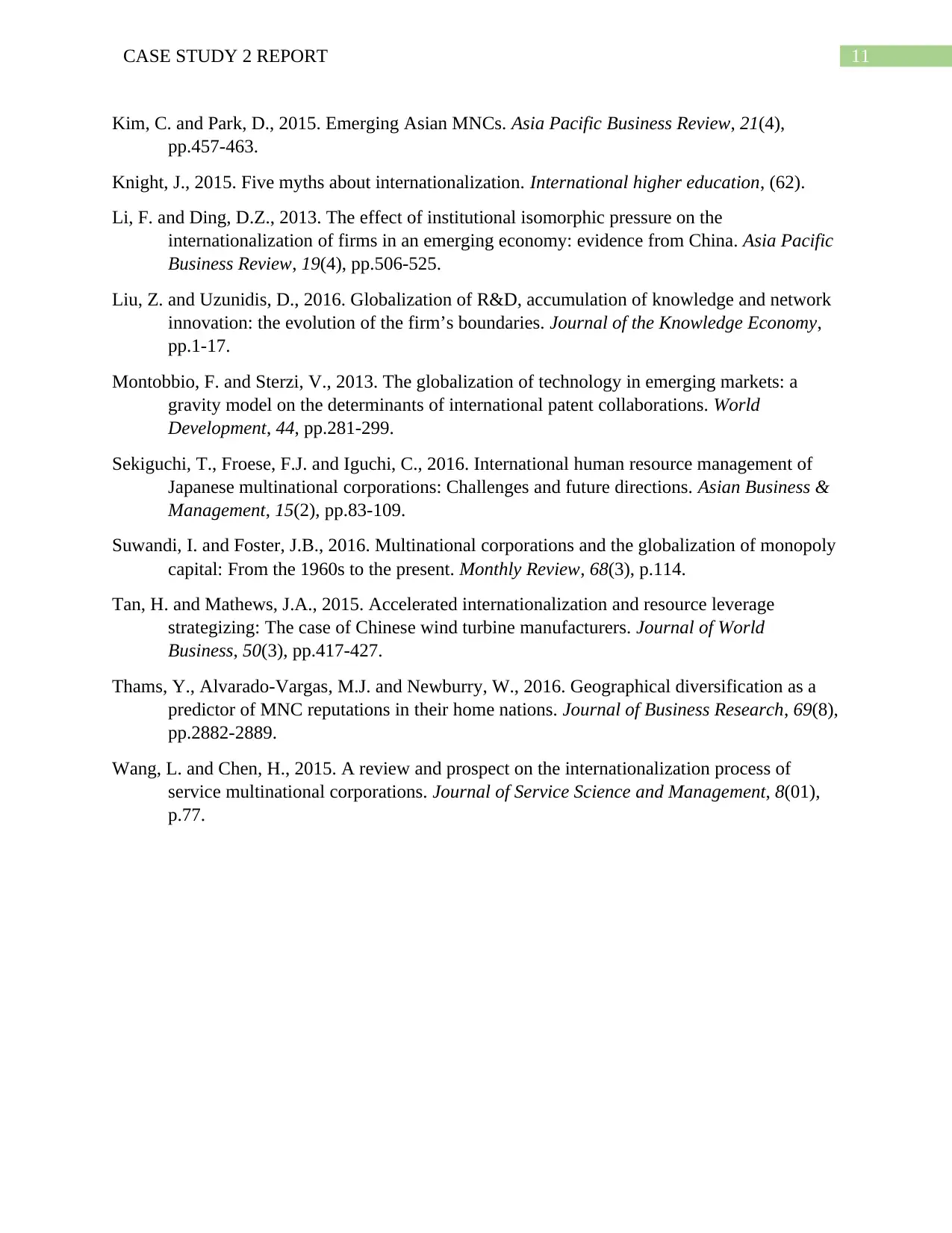
11CASE STUDY 2 REPORT
Kim, C. and Park, D., 2015. Emerging Asian MNCs. Asia Pacific Business Review, 21(4),
pp.457-463.
Knight, J., 2015. Five myths about internationalization. International higher education, (62).
Li, F. and Ding, D.Z., 2013. The effect of institutional isomorphic pressure on the
internationalization of firms in an emerging economy: evidence from China. Asia Pacific
Business Review, 19(4), pp.506-525.
Liu, Z. and Uzunidis, D., 2016. Globalization of R&D, accumulation of knowledge and network
innovation: the evolution of the firm’s boundaries. Journal of the Knowledge Economy,
pp.1-17.
Montobbio, F. and Sterzi, V., 2013. The globalization of technology in emerging markets: a
gravity model on the determinants of international patent collaborations. World
Development, 44, pp.281-299.
Sekiguchi, T., Froese, F.J. and Iguchi, C., 2016. International human resource management of
Japanese multinational corporations: Challenges and future directions. Asian Business &
Management, 15(2), pp.83-109.
Suwandi, I. and Foster, J.B., 2016. Multinational corporations and the globalization of monopoly
capital: From the 1960s to the present. Monthly Review, 68(3), p.114.
Tan, H. and Mathews, J.A., 2015. Accelerated internationalization and resource leverage
strategizing: The case of Chinese wind turbine manufacturers. Journal of World
Business, 50(3), pp.417-427.
Thams, Y., Alvarado-Vargas, M.J. and Newburry, W., 2016. Geographical diversification as a
predictor of MNC reputations in their home nations. Journal of Business Research, 69(8),
pp.2882-2889.
Wang, L. and Chen, H., 2015. A review and prospect on the internationalization process of
service multinational corporations. Journal of Service Science and Management, 8(01),
p.77.
Kim, C. and Park, D., 2015. Emerging Asian MNCs. Asia Pacific Business Review, 21(4),
pp.457-463.
Knight, J., 2015. Five myths about internationalization. International higher education, (62).
Li, F. and Ding, D.Z., 2013. The effect of institutional isomorphic pressure on the
internationalization of firms in an emerging economy: evidence from China. Asia Pacific
Business Review, 19(4), pp.506-525.
Liu, Z. and Uzunidis, D., 2016. Globalization of R&D, accumulation of knowledge and network
innovation: the evolution of the firm’s boundaries. Journal of the Knowledge Economy,
pp.1-17.
Montobbio, F. and Sterzi, V., 2013. The globalization of technology in emerging markets: a
gravity model on the determinants of international patent collaborations. World
Development, 44, pp.281-299.
Sekiguchi, T., Froese, F.J. and Iguchi, C., 2016. International human resource management of
Japanese multinational corporations: Challenges and future directions. Asian Business &
Management, 15(2), pp.83-109.
Suwandi, I. and Foster, J.B., 2016. Multinational corporations and the globalization of monopoly
capital: From the 1960s to the present. Monthly Review, 68(3), p.114.
Tan, H. and Mathews, J.A., 2015. Accelerated internationalization and resource leverage
strategizing: The case of Chinese wind turbine manufacturers. Journal of World
Business, 50(3), pp.417-427.
Thams, Y., Alvarado-Vargas, M.J. and Newburry, W., 2016. Geographical diversification as a
predictor of MNC reputations in their home nations. Journal of Business Research, 69(8),
pp.2882-2889.
Wang, L. and Chen, H., 2015. A review and prospect on the internationalization process of
service multinational corporations. Journal of Service Science and Management, 8(01),
p.77.
⊘ This is a preview!⊘
Do you want full access?
Subscribe today to unlock all pages.

Trusted by 1+ million students worldwide
1 out of 12
Related Documents
Your All-in-One AI-Powered Toolkit for Academic Success.
+13062052269
info@desklib.com
Available 24*7 on WhatsApp / Email
![[object Object]](/_next/static/media/star-bottom.7253800d.svg)
Unlock your academic potential
Copyright © 2020–2025 A2Z Services. All Rights Reserved. Developed and managed by ZUCOL.





